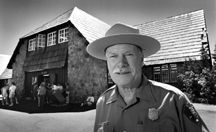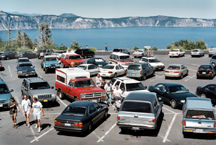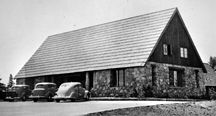Crater Lake officials have plan to improve the park’s ambience
Mail Tribune
Medford, Oregon
August 8th, 1998
BY BILL KETTLER
Footpaths and native plants would replace parking spaces at Crater Lake National Park under a $15 million renovation plan.
Renovating the rim
Photo by Jim Craven
Visitors come to Crater Lake looking for something spectacular, but the first thing they see is a parking lot.
The managers of Oregon’s only national park want visitors to get a better first impression of Crater Lake. And they think a plan to tear out a big parking lot and rehabilitate several of the park’s oldest buildings will give people something to rave about.
“You really should have a sense of arrival when you see the lake,” said John Miele, the park’s management assistant. “And you don’t have it now.
“You walk out there now to see Crater Lake and you have to dodge cars.”
If Congress approves money to implement the park’s new visitor services plan, the scene at the rim of Crater Lake will change dramatically. The $15 million plan, approved by the National Park Service in July, will allow visitors to view Crater Lake in a more natural setting. Miele said it will also diminish parking lot congestion, reduce commercial activity at the rim and restore several 70-year-old buildings to their original appearance.
The 1940s-vintage cafeteria at Crater Lake’s Rim Village used to look like this —
and will again, if a renovation plan goes through.
Under the plan, the large parking lot between the cafeteria and the lake will be moved behind the cafeteria. Miele said the newly vacant land will be landscaped with pedestrian paths and native plants to create a “leisurely pedestrian environment” for visitors to approach the lake.
The cafeteria will be restored to look the way it did when it was built in 1928. Three additions to the building will be razed, leaving a steep-roofed, wood-and-stone structure about one-fourth the size of the existing cafeteria. There will be a small, modern deli and gift shop in the cafeteria, but most food service and gift shop operations will be moved to Mazama Village, seven miles below the rim. The park’s concessionaire will build a new restaurant and gift shop there.
A Rim Village Historic District will include the cafeteria, two old comfort stations and several other buildings, including a photographic studio built by Robert Kiser in the 1920s.
The Kiser studio now serves as a visitor center at the rim, but Miele said it is too small to provide the displays to help visitors understand how the lake was formed. The historic district also will include a nearby wood-framed, two-story building known as the Community House, which was used for visitor programs in the 1920s.
A new three-story visitor center will be built near the rim, with a third-floor observation deck.
“You could walk out and get the panoramic view of Crater Lake,” said Miele. “And in the wintertime, you’d look across a broad expanse of sparkling white snow that would be the backdrop for Crater Lake.”
Miele said the new plan reflects a growing sense among park managers that bigger is not necessarily better. It replaces a 1980s vision for the Rim Village area that featured a multistory hotel and a subterranean parking garage.
The previous plan would have cost as much as $60 million to $70 million to implement. Park Superintendent Al Hendricks said the new $15 million plan reflects the public’s expectation that government should spend less. The new plan also expects the park’s concessionaire to share part of the cost. Whoever wins the park’s new 15-year concession contract will be required to spend as much as $5 million on improvements for visitor services such as the new restaurant.

Crater Lake management assistant John Miele says plans for the park reflect the idea that bigger is not necessarily better. It replaces a 1980s vision for the Rim Village area that featured a multistory hotel and a subterranean parking garage.
While there’s no assurance that Congress will fund the project, Hendricks said “the likelihood of success on a $15 million project is considerably greater than the previous $70 million project.”
Hendricks said the new vision for Rim Village started to emerge around 1995, when the restored Crater Lake Lodge reopened. Park managers realized they would be renegotiating the park’s concession contracts in 1997, and they began thinking about ways they could enhance visitors’ view of the lake, the park’s prime resource.
Miele said the public’s warm acceptance of the restored lodge turned planners’ attention to other historic buildings, such as the cafeteria and several old comfort stations. Restoring the old buildings fit the park service’s mission to preserve America’s cultural heritage, because the buildings are good examples of the rustic wood-and-stone architecture used at national parks across the West in the 1920s.
Park historian Steve Mark said the National Park Service had a building boom in the 1920s, when the easy affordability of private cars brought the first flood of visitors to national parks. The style, which builders used throughout the 1920s and ’30s, also can be seen in buildings at Mount Lassen and Mount Rainier national parks.
At Crater Lake, later examples of the style can be seen in the park administration buildings, which are situated in a group of buildings just before the road begins its final climb to the rim. Mark said the buildings reflect “a happy intersection of funding, skilled labor and good design.”
Park managers would like to make the changes quickly, but they have to wait on money from Congress, and funding moves slowly. Funding decisions for the federal 1999 budget year that begins in October already have been made. The project will have to compete with other National Park Service funding requests, and projects sometimes wait a year or more to gain approval.
“There’s always a delay of a couple of years,” said park superintendent Hendricks. “Even if we put in a (request) today, it would be 2000 or 2001 before we could get it into the system.
“The best we can hope for is some consideration for (funding) in 2001. And it may not make it the first year it’s eligible.”
For Miele and others who have worked on the plan, that will mean a long wait.
“I wish I could just snap my fingers,” he said, “and get from here to there.”
Other pages in this section



